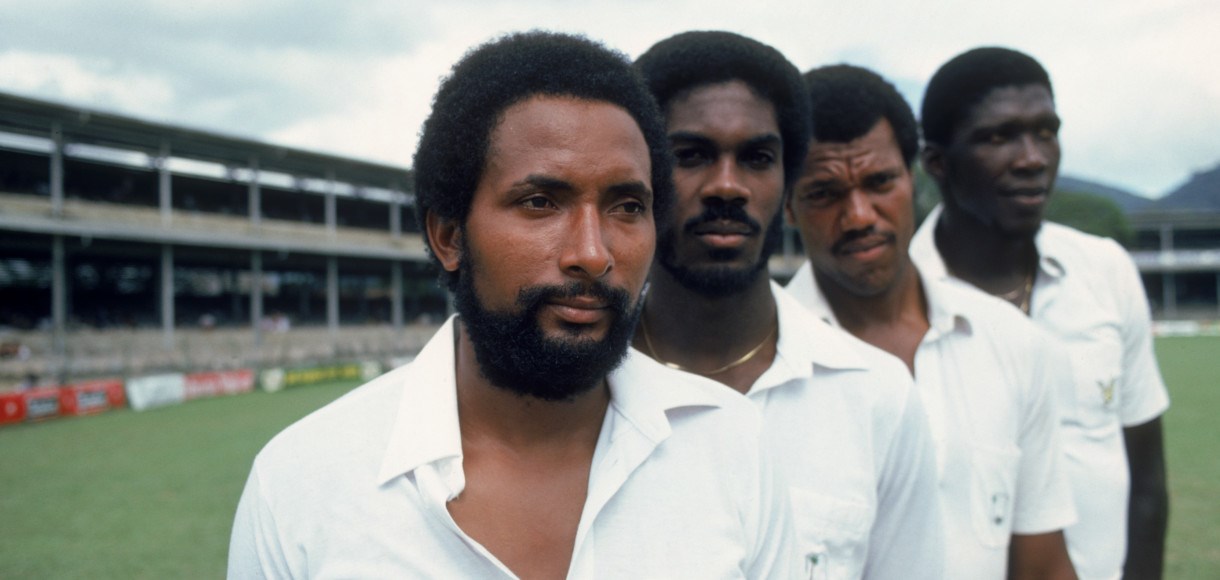Windies legends on the revival of Caribbean cricket

Joel Garner, Curtly Ambrose and Shiv Chanderpaul discuss the West Indies' former era of dominance, and how the current side can hit those heights.
The 1979 World Cup was arguably the most one-sided ever.
The West Indies romped to the trophy, only failing to win handsomely when their group-stage match with Sri Lanka was washed out, with their 92-run victory over England in the final a fair reflection of their dominance.
Gordon Greenidge was comfortably the competition’s top run-scorer with 253. Viv Richards scored 217 runs to come second.
“I enjoyed the kind of cricket we played,” says Joel Garner, the legendary 6ft, 8in fast bowler who took eight of his 146 ODI wickets in that tournament.
“We just went for it. Really and truly, the most important thing was that we enjoyed each other’s company. We supported each other along the way.”
The Windies - to win the 2019 World Cup in the latest cricket betting - were formidable throughout the 1980s and 1990s, as Richie Richardson inherited the team from Viv Richards and ushered in the era of Brian Lara, Shiv Chanderpaul, Curtly Ambrose and Courtney Walsh.
That period of dominance, which was made possible due to the perfect combination of intimidation, aura and skill, remains the most fabled and feared in the history of cricket.
Which makes the challenging times that West Indian cricket has suffered since all the more difficult to comprehend.
“It’s really sad to see West Indies cricket the way it is,” says Ambrose, who took 630 international wickets between 1988-2000, including 24 in World Cups.
“We were so accustomed to being No. 1 in the world and being the team that everyone wants to beat.
“To see the decline as a former cricketer is very hard to take.”
West Indies’ nadir came at the turn of the decade. Between February 2009 and July 2012, they won just two of 33 Test matches, while the knock-on effect of their ODI form was that they failed to qualify for the 2017 Champions Trophy through the rankings system.
“There was always going to be a decline,” Ambrose says. “No team can rule the world forever.
“There is going to be a time when you lose players. It was going to be difficult to find another Clive Lloyd, another Viv Richards, another Brian Lara, another Malcolm Marshall.
“But we are taking a little too long, in my opinion, to bounce back.
“I believe we have enough talent in the region to get back somewhere in the top three of world cricket.”
That much is not in doubt.
In 2016, Daren Sammy led the West Indies to the World T20 title, offering a joyful reminder of their ability to compete at the top of the world game.
In order to prevent the same mistakes from happening again, the CWI have moved to make the entire domestic cricket setup professional in the last six years, incentivising youngsters to take up cricket as a full-time career.
And then there is the emergence and popularity of the CPL – the Caribbean franchise T20 tournament – which can help transform the success of the team, if channelled correctly.
“T20 cricket is good for the consumers and people who run the tournaments,” says Garner,
“But it’s important that the money goes back into cricket.
“If we want to have the future of cricket, then you invest the money you make back into the grassroots level.
“That is where the next set of cricketers are coming from.”
Shiv Chanderpaul, whose ODI run tally for the West Indies is only bettered by Brian Lara and Chris Gayle, is confident that the administration has turned a corner.
“We do not have the money that is being pushed into cricket that another board might have,” he says.
“But we’ve done a lot in the last few years.
“I used to do everything on my own without any money, no contracts, nothing. I had to find my own money if I had to travel.
“Now the countries in the Caribbean all have contracted players, the local boys all have contracts. That means all the boys are going to play in regional tournaments.”
The improvement is beginning to show in the West Indies’ results.
A 2-1 victory in the three-match Test series against England in January and February was followed by a 2-2 draw with World No. 1 team in the subsequent ODI series.
They head into this summer’s World Cup as underdogs, but also as many people’s dark horses.
The only potential issue is that the last decade’s lost generation means that the current team, featuring talents such as Shai Hope and Shimron Hetmyer, is inexperienced.
Even Darren Bravo, Kemar Roach and Shannon Gabriel, all aged 30 or 31, have not played much international cricket for their age.
“What you have to understand is that the great teams of the past had lots of senior guys to nurture the new guys that are coming into the team,” Ambrose says.
“Currently all these guys are basically starting their careers. They are learning on the job. It is going to take some time.”
If only there were a pool of ex-players willing to lend their experience, you might ask.
“When I was in the team, I would talk with them and help them, particularly when I was out in the middle,” Chanderpaul says.
“I see the England Cricket Board put Mark Ramprakash and Graeme Thorpe as batting consultants. That is something we have to start looking at.
“We have a lot of guys with experience in the Caribbean. We need a team of them to go out and work with young players to help them understand their cricket, because there is a lot of talent.”
With things heading in the right direction, taking Chanderpaul’s advice could see the World Cup-winning heroics of 1979 replicated sooner than might have seemed possible.




































